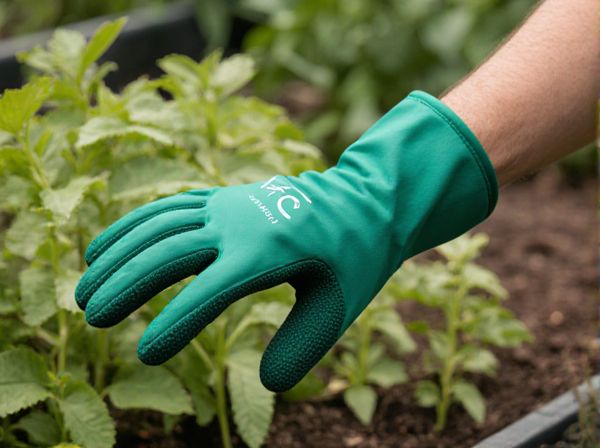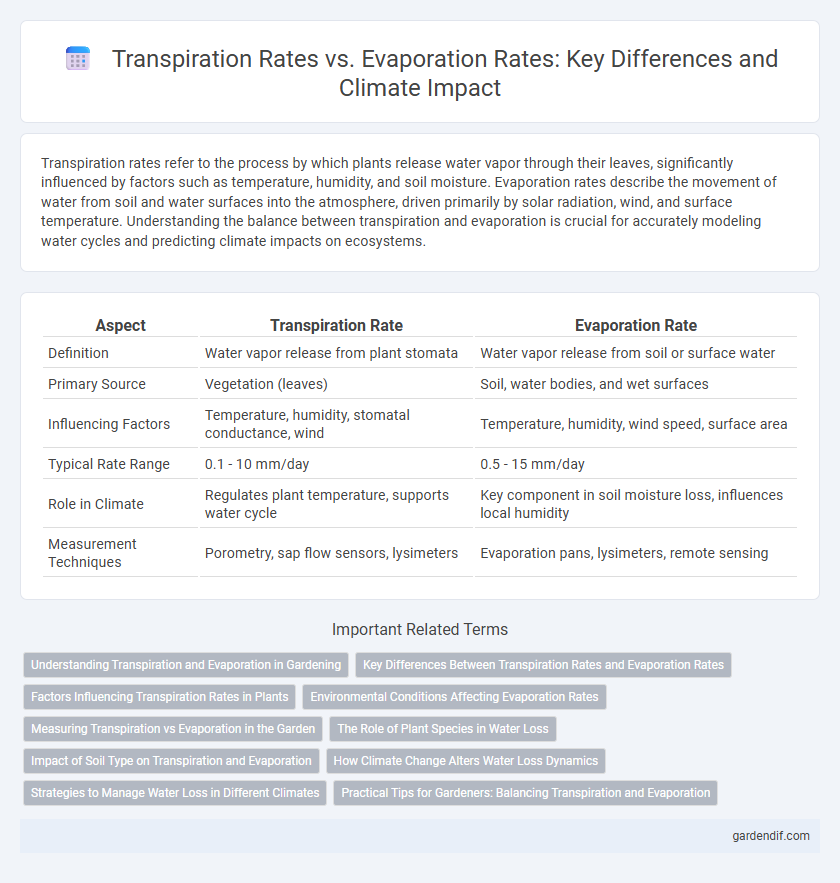
Transpiration rates vs Evaporation rates Illustration
Transpiration rates refer to the process by which plants release water vapor through their leaves, significantly influenced by factors such as temperature, humidity, and soil moisture. Evaporation rates describe the movement of water from soil and water surfaces into the atmosphere, driven primarily by solar radiation, wind, and surface temperature. Understanding the balance between transpiration and evaporation is crucial for accurately modeling water cycles and predicting climate impacts on ecosystems.
Table of Comparison
| Aspect | Transpiration Rate | Evaporation Rate |
|---|---|---|
| Definition | Water vapor release from plant stomata | Water vapor release from soil or surface water |
| Primary Source | Vegetation (leaves) | Soil, water bodies, and wet surfaces |
| Influencing Factors | Temperature, humidity, stomatal conductance, wind | Temperature, humidity, wind speed, surface area |
| Typical Rate Range | 0.1 - 10 mm/day | 0.5 - 15 mm/day |
| Role in Climate | Regulates plant temperature, supports water cycle | Key component in soil moisture loss, influences local humidity |
| Measurement Techniques | Porometry, sap flow sensors, lysimeters | Evaporation pans, lysimeters, remote sensing |
Understanding Transpiration and Evaporation in Gardening
Transpiration rates in plants regulate water movement from roots to leaves, directly impacting soil moisture levels in gardening environments. Evaporation rates depend on external factors such as temperature, humidity, and wind, driving water loss from soil and plant surfaces. Understanding the balance between transpiration and evaporation helps optimize irrigation strategies for healthy plant growth and efficient water use.
Key Differences Between Transpiration Rates and Evaporation Rates
Transpiration rates refer to the amount of water vapor released from plant leaves during photosynthesis, heavily influenced by factors like stomatal opening, humidity, and temperature. Evaporation rates involve the process of water turning into vapor from soil, water bodies, or surfaces, driven primarily by solar radiation, wind, and atmospheric conditions. Key differences lie in transpiration being a biological process controlled by plant physiology, while evaporation is a physical process dependent on environmental variables.
Factors Influencing Transpiration Rates in Plants
Transpiration rates in plants are influenced by factors such as leaf surface area, stomatal density, ambient temperature, humidity, and wind speed, which regulate water vapor release. Soil moisture availability directly impacts the plant's ability to maintain transpiration, while light intensity affects stomatal opening, enhancing water loss. Compared to evaporation, transpiration is a biologically controlled process primarily driven by plant physiology and environmental conditions.
Environmental Conditions Affecting Evaporation Rates
Environmental factors such as temperature, humidity, wind speed, and solar radiation significantly influence evaporation rates, with higher temperatures and wind speeds accelerating water loss from surfaces. Low humidity conditions create a steeper vapor pressure gradient, enhancing evaporation compared to transpiration, which is regulated by plant stomata. Soil moisture levels and vegetation cover further affect the balance between transpiration and evaporation by modulating water availability and microclimate conditions.
Measuring Transpiration vs Evaporation in the Garden
Transpiration rates in a garden are measured using porometers or lysimeters that assess water vapor loss directly from plant leaves, providing precise data on plant water use. Evaporation rates are typically measured with an evaporimeter or by using pan evaporation methods, which capture water loss from soil or open water surfaces. Combining these measurements helps optimize irrigation schedules by distinguishing water loss through plants versus soil surface evaporation.
The Role of Plant Species in Water Loss
Plant species significantly influence transpiration rates due to variations in leaf morphology, stomatal density, and cuticle thickness, which regulate water loss through stomatal openings. Transpiration can account for a large proportion of total evapotranspiration in vegetated areas, often surpassing evaporation rates from soil surfaces in dense plant communities. Understanding species-specific transpiration rates is crucial for climate models predicting water cycles and assessing ecosystem responses to drought and temperature changes.
Impact of Soil Type on Transpiration and Evaporation
Soil type significantly influences transpiration and evaporation rates by affecting water retention and availability to plants. Sandy soils, with low water-holding capacity, lead to higher evaporation rates and reduced transpiration due to limited moisture for root uptake. Conversely, clay soils retain more moisture, promoting increased transpiration while slowing surface evaporation, thereby impacting overall water cycle dynamics in ecosystems.
How Climate Change Alters Water Loss Dynamics
Climate change accelerates transpiration rates by raising temperatures and increasing atmospheric demand for moisture, intensifying water loss from plants. Elevated temperatures also boost evaporation rates from soil and water bodies, disrupting local humidity and soil moisture levels. These altered water loss dynamics contribute to shifts in ecosystem resilience and agricultural productivity under changing climatic conditions.
Strategies to Manage Water Loss in Different Climates
Transpiration rates vary widely across plant species and climates, typically lower in arid regions due to stomatal regulation, while evaporation rates depend heavily on temperature, humidity, and wind speed. Strategies to manage water loss include selecting drought-resistant crops with deep root systems for dry climates and employing mulch or shade structures to reduce soil evaporation in hot, sunny environments. Optimizing irrigation timing and adopting technologies like drip irrigation further balance transpiration and evaporation, conserving water in both humid and arid climates.
Practical Tips for Gardeners: Balancing Transpiration and Evaporation
To balance transpiration and evaporation rates effectively, gardeners should increase soil moisture retention by applying mulch, which reduces water loss through evaporation. Selecting drought-tolerant plant species with lower transpiration rates helps maintain plant health during dry periods. Proper watering techniques, such as early morning irrigation, minimize evaporation and ensure efficient water absorption by plant roots.
Transpiration rates vs Evaporation rates Infographic

 gardendif.com
gardendif.com